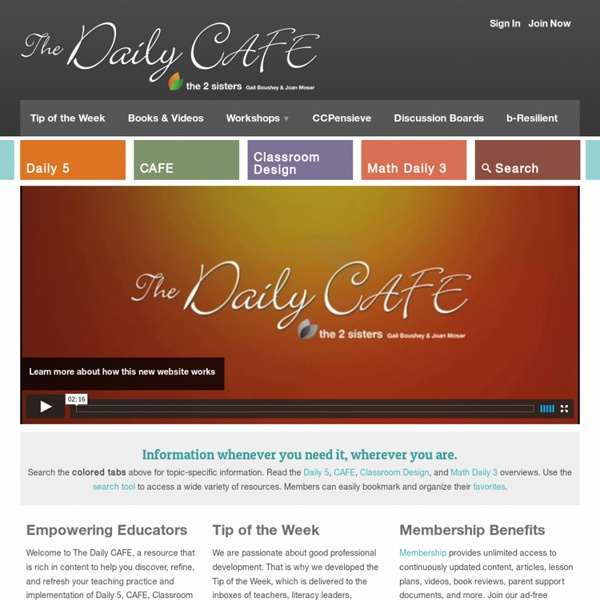Daily 5: Posters and Rotation Cards! (UPDATED!) - One Extra Degree
I currently teach third and fourth grade kiddos, and I enjoy every second of it! Over the past eight years, I have absolutely fallen in LOVE with my job! I am extremely passionate about teaching and creating, and I enjoy being able to share that passion with others! I believe that teaching stretches far beyond the content areas. First and foremost, I work on establishing strong relationships with my students based on trust, mutual respect, and empathy. I realize that I am educating little people, and that even little people have problems that occasionally distract them from learning.
40 Viewing Comprehension Strategies
40 Viewing Comprehension Strategies: Watching Videos Like You Read A Book by Terry Heick You can’t watch a video like you read a book; the modalities couldn’t be much more different. On the surface level a video uses light, color, sound, and moving images, with the potential for adding text and shape and color and light filters as overlays to communicate ideas, while the most basic text structures use alphanumeric symbols, paragraph and sentence structure, and an assortment of text features (e.g., white space, headings and subheadings, fonts, etc.) to convey their message. There is much, much more to it than this. Videos are meant to be consumed in short bursts, while literature, for example, is meant to be “sat with.”
UDL Goal Setter: Tools & Activities: Teaching Every Student
The key to helping all students achieve is identifying and removing barriers from our teaching methods and curriculum materials. One effective way to do this is to expand your teaching toolbox with digital media and software. To accommodate a broad spectrum of learners, universally designed curricula require a range of options for accessing, using, and engaging with learning materials. The materials themselves, as well as the teaching approaches, need to be sufficiently flexible to support varied pathways towards common learning goals. Building digital content and tools into your curriculum can help you provide the necessary flexibility to reach diverse learners.
Youtube 4 Teachers
VIDEO IS THE NEW PEN! (…and it’s mightier too!) The thought makes many people think the world has ended but for 21st Century kids, videoing their thoughts and creations and experiences and then publishing it to the world is as easy as picking up a pen. In fact, most are more likely to have a device ready to film, edit, add subtitles and music than a pen or pencil. I like to think we only ever used pens because we didn’t have a video camera in our pocket, sorry if that upsets anyone. For example, my kids do write poems but performing them as videos makes them really think about the effect their words have on an audience.
Five-Minute Film Festival: Reimagining the Library
April 2015 marks the 30th anniversary of School Library Month. As our libraries evolve in the age of digital information, they need our help more than ever to stay well-funded and supported so they can grow in their critical role as advocates of technology and information literacy. Should they become learning commons, gathering places for trading information, technology hotspots, makerspaces, or all of the above?
Before We Flip Classrooms, Let's Rethink What We're Flipping To
Integrated into their regular math classes, Globaloria students access online video tutorials and receive expert advice on how to build original educational video games about math topics. Photo credit: World Wide Workshop We're hearing a lot of talk about education in these back-to-school days, but a few conversations rise above the din. One such is the chatter about "flipped classrooms,"1 in which students listen to lectures at home and do homework at school. We also hear names like TED, Codecademy, Khan Academy and Knowmia bandied about, not to mention the term "MOOC"2 and such brands as Udacity, Coursera, MITx, edX . . . What's it all about?
The 7 Most Powerful Ideas In Learning Available Right Now
Tomorrow’s Learning Today: 7 Shifts To Create A Classroom Of The Future by Terry Heick For professional development around this idea or others you read about on TeachThought, contact us. Let’s take a look at the nebulous idea of the “classroom of the future.”
Preparing a Classroom Culture for Deeper Learning
After reading an excerpt from the Declaration of Independence, students form a circle to engage in conversation about liberty and the pursuit of happiness. The inquiry circle begins with two questions posed by the teacher: What is more important, liberty or the pursuit of happiness? Are liberty and the pursuit of happiness inalienable rights? To begin, some students argue that liberty and the pursuit of happiness are only open to the people who follow rules within a society.
UDL Examples and Resources
Disclaimer: The examples and resources highlighted on these pages have been gathered for educational purposes. CAST does not necessarily endorse the products listed, nor does their inclusion here mean that these products are complete expressions of the UDL principles and guidelines. They may illustrate certain principles and not others. Below, you will find teacher-friendly examples and resources that illustrate each of the UDL checkpoints. Exploring these examples and resources not only helps to clarify what is meant by each of the checkpoints but also gives teachers ideas of ways to implement UDL in their classrooms.
The 10 Skills Modern Teachers Must Have
The above image is 8.5×11″ so you can print it out. PDF is available here . There’s been a lot of talk about 21st century learners, 21st century teachers, and connected classrooms. There’s a daily influx of new technology into your inbox and your classroom feels woefully behind the times even if you’re flipping your 1:1 iPad classroom that’s already online and part of a MOOC .



